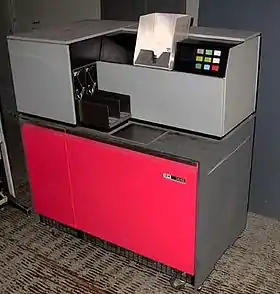IBM 1440
The IBM 1440 computer was announced by IBM October 11, 1962.[1] This member of the IBM 1400 series was described many years later as "essentially a lower-cost version of the 1401,"[2] and programs for the 1440 could easily be adapted to run on the IBM 1401.
Despite what IBM described as "special features ... to meet immediate data processing requirements and ... to absorb increased demands," the 1440 didn't quite attain the same commercial success as the 1401,[2] and it was withdrawn on February 8, 1971.
Author Emerson Pugh wrote that the 1440 "did poorly in the marketplace because it was initially offered without the ability to attach magnetic tape units as well." (referring to offering both tape and disk).[3]
System configuration
The IBM 1441 processing unit (CPU) contained arithmetic and logic circuits and up to 16,000 alphanumeric storage positions.[4]
The console was either a Model 1 or, when an electric typewriter was added, a Model 2, of the IBM 1447 operator's console.[1]

Peripherals
The following peripherals were available:
- IBM 1442 card reader/punch
- Model 1 read up to 300 cards a minute and punched up to 80 columns a second
- Model 2 read up to 400 cards a minute and punched up to 160 columns a second
- Model 4, a read-only unit, read up to 400 cards/minute.
An IBM 1440 could be configured with a choice of:
- IBM 1443 flying typebar printer
- Basic rate of 150 lines a minute and up to 430 lines a minute, depending on typebar
- Interchangeable typebars having character sets of 13, 39, 52,[8] and 63 characters
Software

Click on above image to enlarge
IBM 1440 Autocoder was the assembly language provided by IBM. An IOCS was also provided,[12] as was a collection of "Disk File Organization Routines".

Pricing
The cost and rental rate were:
- Purchase price: $90,000 and up, depending on system configuration.
- Rental rate: $1,500 and up, monthly rental, depending on system configuration.
Installations
Notable installations included a high-end 1440 at the Chicago Police Department installed by reformist superintendent Orlando Winfield Wilson in the early 1960s.
In the 1960s, Polish ZOWAR was officially the first customer for IBM in Poland after WWII, despite the Iron Curtain.[13]
In 2012 the TechWorks! Prototype Workshop of the Center for Technology & Innovation (CT&I) in Binghamton, New York successfully resurrected a 1440 system including a CPU and console, a 1311 disk drive, and a 1442 card reader/punch.[14]
An example of a more fully configured 1440[15] was:
- five disk drives
- two magnetic tape drives
- two card reader-punches
- one high-speed printer
- an optical reader (to transfer specially coded medical data forms to magnetic tape)
Photos
See also
References
- "1440 Data Processing System". IBM.com.
- Ryan Rhodes (September 2012). "A 1440 Data Processing System Finds New Life After 50 Years". IBM Systems Journal.
- Emerson W. Pugh (2009). Building IBM: Shaping an Industry and Its Technology. ISBN 978-0262307680.
- A convenience sampling of mid-1970s 1440 For-Sale ads showed 8K and 12K as quite common
- "Technical Newsletter (No. N24-0219, File No. 1440-01)" (PDF). June 15, 1964.
- "Executive Guide to the IBM 1440 Data Processing System" (PDF). 1962.
- IBM 1442 Card Read-Punch Models 1 and 2 IBM 1442 Card Reader Models 3 and 4 (PDF). IBM. Archived from the original (PDF) on 2015-04-22. Retrieved 2017-12-21.
- "A-Z upper case, 10 digits 0-9, and 16 special characters: "Executive Guide to the IBM 1440 Data Processing System" (PDF). 1962.
- not part of the initial offering
- a pair of 7335 Tape Drives were part of a cited 1440 configuration - "For sale". Computerworld. November 26, 1975. p. 38.
- "DPD chronology".
- [bitsavers.org/pdf/ibm/1401/C20-1601-9_1401_pgmCatApr69.pdf "Catalog of Program for IBM 14.. - 11140-10-010 (Version 2)"] Check
|url=value (help) (PDF). - https://historiainformatyki.pl/historia/seminarium-historyczne-pti-krzysztof-bulaszewski-ibm-w-polsce-poczatki
- Rhodes, Ryan (Sep–Oct 2012). "A 1440 Data Processing System Finds New Life After 50 Years". IBM Systems Magazine.
- reported in 1964: "Research News - Volumes 15-17". University of Michigan. Office of Research Administration. 1964. p. 33.